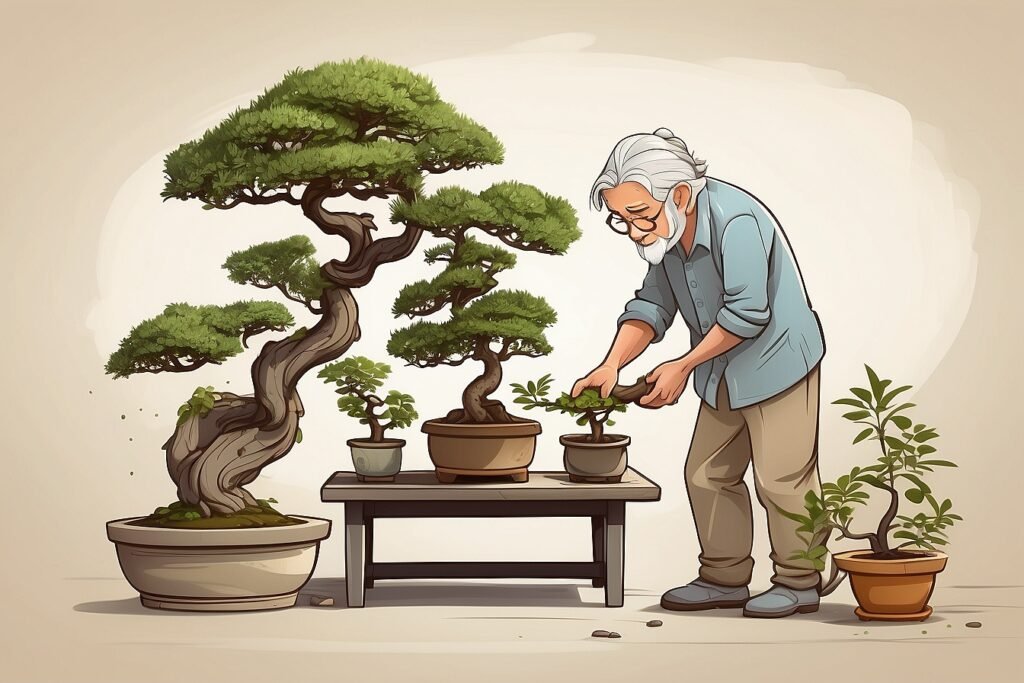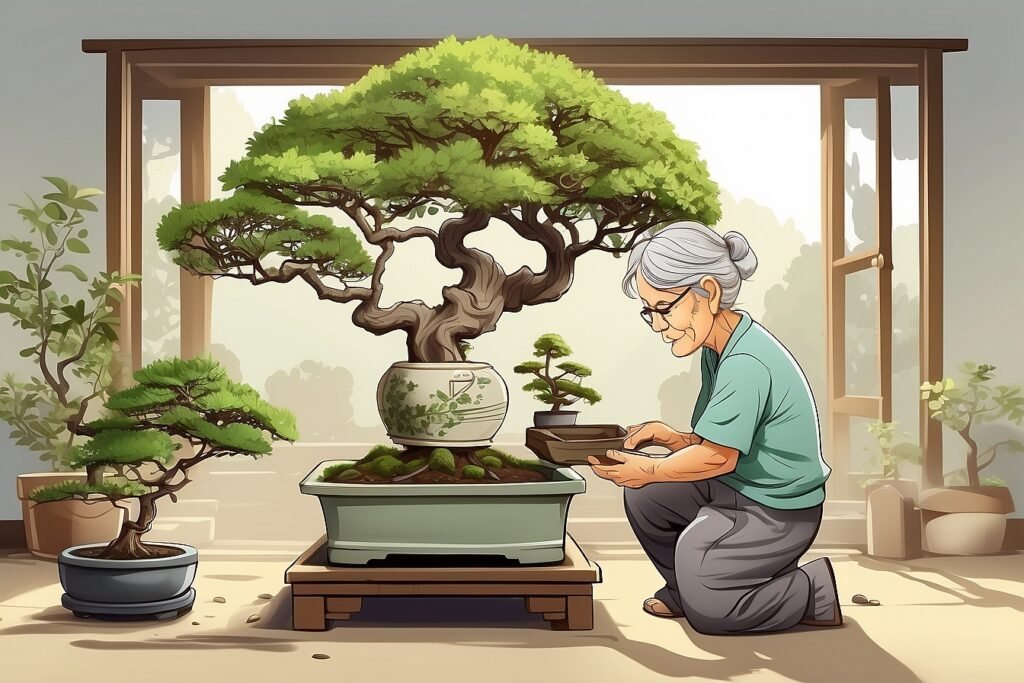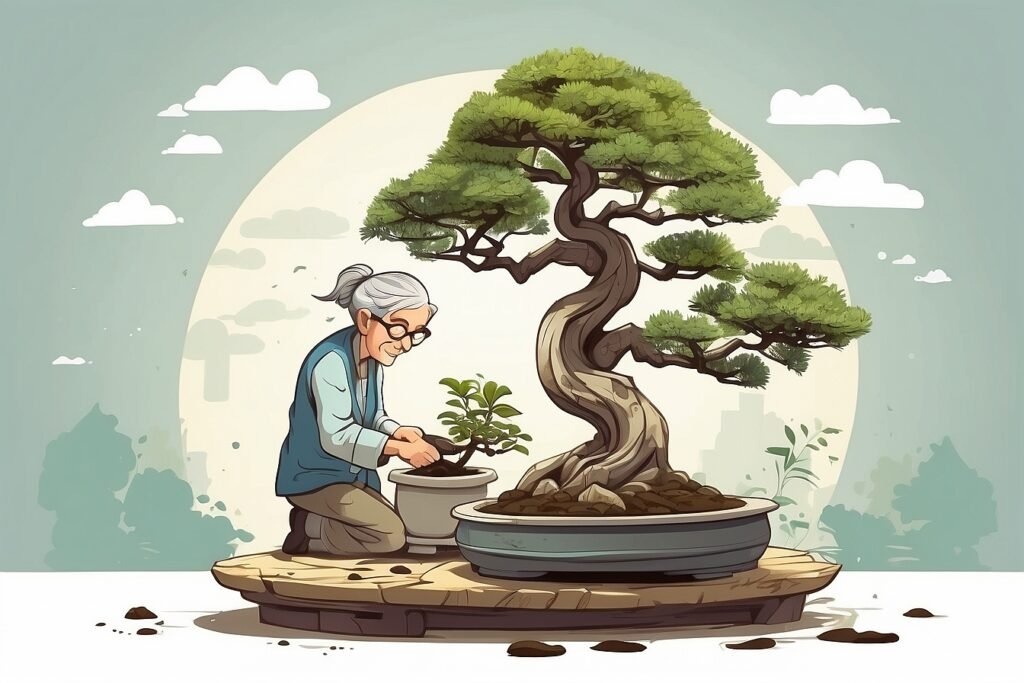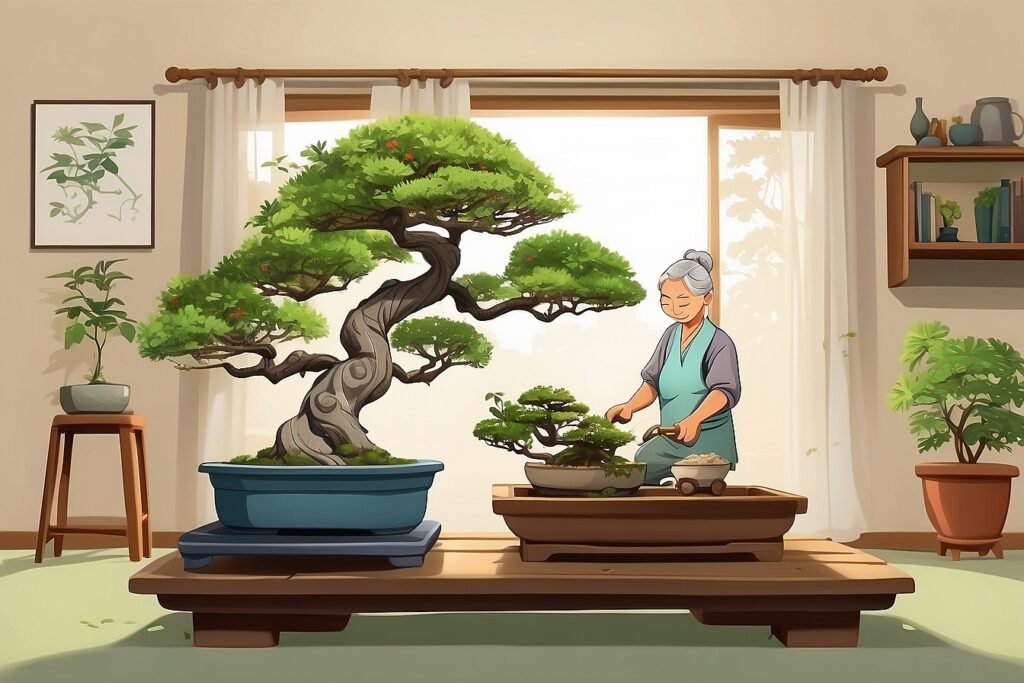Brief Overview of Bonsai Banana Trees
Bonsai Banana Trees are miniature versions of regular banana plants specifically cultivated to thrive in small containers. They love sunlight, heat, and humidity, which makes them perfect for tropical regions.
And guess what? You can grow them at home, either from seeds or corms. Compared to other bonsai plants, they require less maintenance, making them an excellent choice for beginners.

Growing a Bonsai Banana Tree is a fun hobby, and it adds a unique touch to your outdoor spaces. You can grow them in pots, which makes them perfect for balcony and terrace gardens. However, it’s essential to research their specific care requirements to ensure they thrive in your environment.
Here are some key points which we properly discuss further
- Sunlight Requirement: 6-8 hours of direct sunlight daily.
- Watering: Keep soil moist and avoid drying out.
- Pest and Disease Control: Use organic pesticides and clear insects with strong water spray.
- Winter Care: Provide sunlight; move indoors if the temperature drops below 57°F.
- Protection: Shield from frost, cold weather, and strong winds.
- Soil and Fertilizer: Well-draining soil with humus; fertilize regularly.
- Pruning: Prune after 6-8 weeks of healthy growth or after fruit harvest.
- Importance: Adds a unique touch to outdoor spaces, suitable for terrace gardens.
- Unique Aspects: Requires direct sunlight, loves humidity and heat, and less maintenance than other bonsai plants.
| Aspect | Details |
|---|---|
| Origin | Tropical Regions |
| Size | Miniature |
| Growing Method | Seeds or Corms |
| Difficulty Level | Easy |
| Maintenance Level | Low |
Understanding the Basics of Bonsai Banana Trees
Firstly, knowing that Bonsai Banana Trees require much attention and care to thrive is essential. They need the right amount of sunlight, humidity, and consistent watering. You’ll also want to ensure you’re using well-draining soil and regularly fertilizing the tree with a balanced fertilizer.
However, it’s important to remember that moderation is key here. As the tree is bound to a small container, overwatering or overfeeding can cause severe damage or even kill it. Similarly, if you don’t prune the tree correctly, it can result in an unnatural shape or stunted growth. So, it’s crucial to understand the basic requirements of the tree and adapt them accordingly to ensure its healthy growth.

I’m here to assist you every step of the way in your Bonsai Banana Tree journey. Feel free to reach out if you need any further guidance or advice.
| Aspect | Regular Banana Tree | Bonsai Banana Tree |
|---|---|---|
| Size | Can grow up to 25 feet tall | Typically kept under 2 feet tall |
| Container | Grown in the ground | Grown in a small pot or container |
| Care | Requires regular watering, feeding, and sunlight | Requires careful watering, feeding, and sunlight management |
| Pruning | Limited pruning, mainly to remove dead leaves or stems | Regular pruning to maintain size and shape |
| Location | Best suited for outdoor, tropical environments | Can be grown indoors or outdoors |
| Yield | Produces regular-sized bananas | Can produce miniature bananas, depending on the variety |
Step-by-Step Guide to Growing Bonsai Banana Trees
You can start by growing your Bonsai Banana Tree using either banana seeds or a banana corm. If you choose to use banana seeds, soak them in warm water for 24-48 hours to break seed dormancy, and then plant them in a container with well-draining soil. Keep the soil moist, and be patient – germination can take 2-3 weeks to 2-3 months.

If you prefer a banana corm, wash it with lukewarm water and plant it in a shallow pot with well-draining soil. Keep 20% of the corm exposed until leaves develop. Both methods have pros and cons, but don’t worry – I’ll help you determine what’s best.
Once your tree has sprouted, it’s essential to care for it properly to ensure its healthy growth. Water the plant regularly and place it in direct sunlight for at least 6 hours a day, and use deep, humus-rich, and organically rich soil with a pH range between 6 to 7.
Fertilize the tree regularly with a balanced fertilizer, especially during the growing season. And remember to prune the tree every 6-8 weeks for balanced growth and after each harvest to encourage fruit production.
If you’re growing your Bonsai Banana Tree indoors, especially during winter, there are some additional tips to remember. Provide as much sunlight as possible, maintain soil moisture, and fertilize once a month.
And when it comes time to repot your tree, choose a 15-gallon container with proper drainage for planting. Repot every three years and divide suckers from the parent tree.
For optimal growth of your Bonsai Banana Tree, consider planting banana trees in groups for moisture retention, misting the leaves in dry conditions, and avoiding temperatures below 50 degrees Fahrenheit.
Care and Maintenance of Bonsai Banana Trees
Let me share some tips that will help you keep your tree healthy and thriving. To begin with, you’ll need to provide the right growing conditions for your tree. Ensure it gets at least 6 hours of direct sunlight daily, and the temperature is 75 to 95 degrees Fahrenheit.

Water it regularly to keep the leaves hydrated, but do what is necessary. In summer, water twice a month, and reduce watering during winter. Use deep, humus, and organically rich soil with good drainage for optimal growth, and fertilize it regularly, especially during the growing season.
Despite all your efforts, you may encounter some common problems with bonsai banana trees. Pests and diseases are always possible, so watch for earwigs, snails, aphids, mealybugs, and fungal infections. Don’t worry; you can use organic pesticides and remove any infected parts immediately.
Finally, I have some additional tips to ensure the healthy growth of your bonsai banana tree. Report it every three years using a 15-gallon container with proper drainage, provide other nutrients, and maintain soil moisture during winter.
Plant banana trees in groups to create a moist climate, especially in dry conditions, and wipe the leaves occasionally to remove dirt and maintain their health.
Most importantly, choose the appropriate method for growing bonsai bananas, either from seeds or corm, based on personal preference and ease of care.With these tips, you’ll be able to enjoy the beauty of your tropical miniature garden.
Advanced Techniques for Banana Bonsai
If you want to learn about growing bonsai banana trees, I can offer some helpful tips based on my experience and knowledge.

When it comes to performing unique and creative shapes, there are Some techniques you can use. For example, wiring can guide the growth of branches and trunks into desired shapes. Regular pruning can also help maintain a tree’s shape and increase its aesthetic attraction, while defoliation can promote the growth of smaller leaves.
It’s important to remember that these techniques require patience and careful handling to avoid damaging the tree. Additionally, grafting isn’t typically used in bonsai banana tree cultivation, although theoretically, it could combine characteristics from different banana tree varieties into one plant. However, successful grafting requires considerable skill and experience.
There are also several styles of bonsai plant generation, such as the formal upright style, informal upright style, slanting style, and cascade style. Each presents a different aesthetic and can be achieved with careful pruning and shaping.
Recall that bonsai cultivation is an art form that takes patience, skill, and creativity. Don’t be afraid to experiment and create your unique bonsai banana tree masterpiece.
Bonsai Banana Trees in Popular Culture
Did you know that Bonsai banana trees have recently become a cultural phenomenon? They’ve been featured in various media and art forms and have even influenced modern gardening trends, mainly indoor and urban gardening.
One of the best things about these mini banana trees is that they’re perfect for small spaces, making them excellent for indoor gardening. They’re also effortless to care for, requiring minimal watering and pruning. Plus, cultivating and maintaining a bonsai banana tree can be therapeutic, promoting mindfulness and well-being.
Overall, these little trees are charming and adaptable to modern living spaces. A Bonsai banana tree is a fantastic choice, whether you want to add some aesthetic value to your home or garden, reap the therapeutic benefits, or enjoy how easy they are to care for.
Conclusion
Growing a bonsai banana tree is a rewarding experience that lets you enjoy healthy fruit at home. It requires a careful balance of water, sunlight, temperature, soil, fertilizer, regular pruning, and pest control. Protecting the tree from harsh weather conditions is also essential. Despite the challenges, cultivating a bonsai banana tree is worth it for the beauty and satisfaction of nurturing a living plant. We encourage you to try it and experience the joy of growing your fruit.
Frequently Asked Questions About Bonsai Banana Trees
Do banana plants need sun or light?
Yes, banana plants, including bonsai banana trees, thrive in bright, indirect sunlight. They can tolerate direct sunlight but need protection from intense afternoon sun to prevent leaf burn.
Can we keep banana plants indoors?
Absolutely! Bonsai banana trees are perfect for indoor gardening. They can adapt well to indoor conditions as long as they receive enough light and are cared for properly.
Can a bonsai banana work?
Definitely. Bonsai banana trees are not only feasible but also incredibly rewarding to cultivate. They require care and attention like any other bonsai plant, but they can thrive and produce fruit when properly maintained.
How long does a bonsai banana tree live?
A well-cared-for bonsai banana tree can live for 5 to 6 years. Regular pruning, proper watering, and adequate sunlight can significantly extend its lifespan.
How often should we water banana trees?
Banana trees love water but do not like to sit in it. Water your bonsai banana tree when the top inch of soil begins to dry out. Overwatering can lead to root rot, so ensure your tree’s pot has good drainage.
How long does it take for a banana tree to bear fruits?
From seed or corm, a banana tree usually takes about 9 to 12 months to produce fruit under optimal conditions. However, remember that patience is key when it comes to bonsai cultivation.
Why do banana trees drip?
Banana trees often exude a clear liquid from their leaves, a process known as guttation. This happens when the plant’s root pressure forces water up into the stems and leaves, where it escapes through special leaf tips. It’s a natural process and not a cause for concern.
Further Reading and Resources
- The Ultimate Guide to Nurturing Norway Spruce Bonsai
- The Quaking Aspen Bonsai: A Unique Artistry in Miniature Forestry
- Mastering the Art of Douglas Fir Bonsai: A Comprehensive Guide
- Exploring the Eastern Red Cedar as a Bonsai Choice
- The Revolutionary Practice of Hydroponic Bonsai: A Comprehensive Guide
- The Art and Science of Cultivating Honey Locust Bonsai: A Comprehensive





